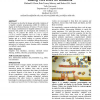Free Online Productivity Tools
i2Speak
i2Symbol
i2OCR
iTex2Img
iWeb2Print
iWeb2Shot
i2Type
iPdf2Split
iPdf2Merge
i2Bopomofo
i2Arabic
i2Style
i2Image
i2PDF
iLatex2Rtf
Sci2ools
ACMIDC
2008
2008
Tangible programming and informal science learning: making TUIs work for museums
In this paper we describe the design and initial evaluation of a tangible computer programming exhibit for children on display at the Boston Museum of Science. We also discuss five design considerations for tangible interfaces in science museums that guided our development and evaluation. In doing so, we propose the notion of passive tangible interfaces. Passive tangibles serve as a way to address practical issues involving tangible interaction in public settings and as a design strategy to promote reflective thinking. Results from our evaluation indicate that passive tangibles can preserve many of the benefits of tangible interaction for informal science learning while remaining cost-effective and reliable. Author Keywords Tangible User Interfaces, museums, informal science learning, children, education, programming languages ACM Classification Keywords H5.2. Information interfaces and presentation (e.g., HCI): User Interfaces
| Added | 12 Oct 2010 |
| Updated | 12 Oct 2010 |
| Type | Conference |
| Year | 2008 |
| Where | ACMIDC |
| Authors | Michael S. Horn, Erin Treacy Solovey, Robert J. K. Jacob |
Comments (0)

